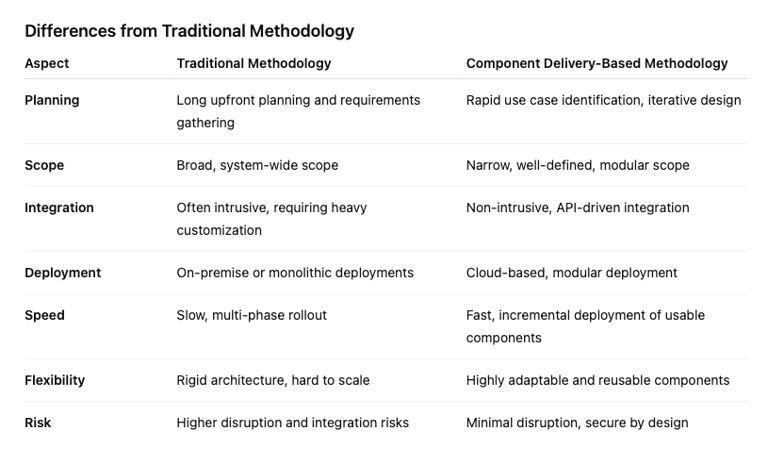Component Delivery Methodology
The component delivery-based methodology is a modern, agile approach to implementing technology solutions. Unlike traditional methodologies that often rely on lengthy planning, heavy customization, and disruptive integration, this approach emphasizes speed, modularity, and minimal intrusion. It focuses on delivering functional components quickly while maintaining security, interoperability, and operational continuity.
1 min read


Key Characteristics
Rapid Use Case Identification
The methodology starts with quickly identifying the most relevant business use case.
Teams focus on understanding immediate business pain points or opportunities, rather than defining broad, long-term system requirements.
This ensures early value delivery and reduces wasted effort on unnecessary features.
Defined Scope and Boundaries
Clear boundaries are established for each component to ensure it addresses a specific business need.
Scope clarity prevents scope creep and allows for focused design and implementation.
Integration-Centric Design
Components are designed to connect seamlessly with existing applications and infrastructure via APIs.
No intrusive modifications are required in legacy systems, preserving operational stability.
Emphasizes configurability and adaptability to client environments rather than full system replacement.
Cloud-Based Deployment
Components are deployed securely in the cloud, leveraging scalable and flexible infrastructure.
Cloud-native design allows for automated deployment, monitoring, and updates without disrupting business operations.
API-Driven Interoperability
Components communicate with client systems and other services using standardized APIs.
This allows components to be reusable, composable, and upgradeable, creating a plug-and-play ecosystem rather than a rigid monolithic system.
Security and Compliance by Design
Security is integrated from the outset, ensuring secure access, data protection, and compliance with relevant standards.
The methodology minimizes risk exposure by isolating components and controlling interaction points with client systems.


Differences from Traditional Methodology
This methodology is ideal for organizations seeking agile, low-risk innovation while maintaining the integrity of their existing infrastructure. It emphasizes component modularity, secure cloud deployment, and rapid integration, making it a practical alternative to traditional, monolithic project delivery approaches.
© OpenSME Pte Ltd.
